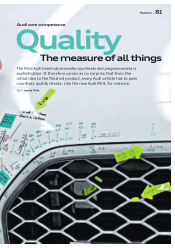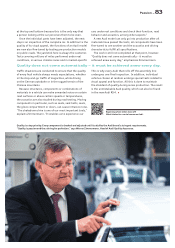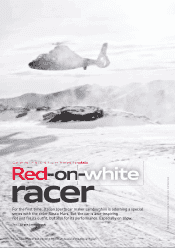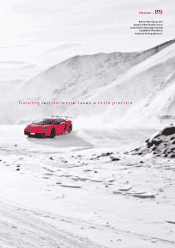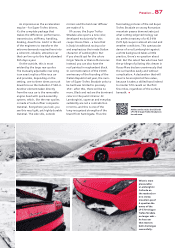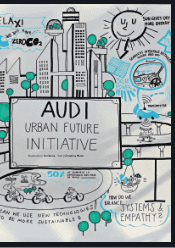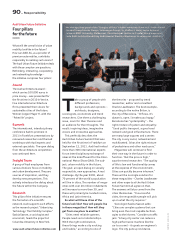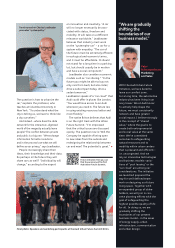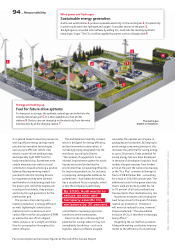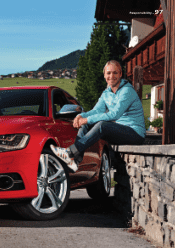Audi 2011 Annual Report Download - page 93
Download and view the complete annual report
Please find page 93 of the 2011 Audi annual report below. You can navigate through the pages in the report by either clicking on the pages listed below, or by using the keyword search tool below to find specific information within the annual report.
Take
a group of people with
diff erent professions,
backgrounds and opinions –
architects, designers,
sociologists, economists and trend
researchers. Give them a challenging
issue, room for their theories and
an audience for their thoughts. The
result: inspiring ideas, imaginative
visions and innovative approaches.
This perfectly describes the
Audi Urban Future Summit that was
held for the fi rst time in Frankfurt on
September 12, 2011. Audi had invited
more than 300 international experts
for an interdisciplinary exchange of
ideas at the kickoff event for the Inter-
national Motor Show (IAA). The sub-
ject: urban mobility in the future.
The goal: an open dialog on socially
responsible, new approaches. A real
challenge. By the year 2030, about
70 percent of the world’s population
will live in cities. The number of mega-
cities with over 20 million inhabitants
will increase to more than 30, and
these will primarily be located in Asia,
Africa and Latin America.
So what will these cities of the
future look like? How will people live
in these megacities? How will they
get from one place to another?
“Cities need reliable systems.
People need social relationships.
With the right combination,
these things make a city exciting
and livable,” according to one of
the theories – proposed by trend
researcher, author and consultant
Charles Leadbeater. The best example,
according to the native Briton, is
the city of Barcelona. “It fl ows, it’s
dynamic, open. It makes you happy.”
Barcelona has “systempathy” – the
right mixture of system and empathy:
“Good public transport, a good road
network and good infrastructure. There
are many large squares and a center.
The city is very social, networked and
multifaceted. It has the right mixture
of pedestrians and other road users.”
Megacities will continue to fi nd
their own way in the future in order to
function. “But the price is high,”
says the trend researcher. “The quality
of life is low and functionality comes
at the expense of the environment.
Cities can quickly become inhuman.”
There will be no single solution for
these megacities – Charles Leadbeater
and other experts at the Audi Urban
Future Summit all agree on that.
The answers will also come from the
cities themselves. “In successful
cities, the responsible people will pick
up on what the city requires.”
Sociologist Saskia Sassen adds:
“Cities are complex systems that can
bring even the most capable technol-
ogies to their knees.” Consider a traffi c
jam: “A busy city center can reduce a
high-performance machine like the
car to a crawl – it upsets an engineer’s
logic. The city puts up resistance.
PHOTOS | AUDI AG (3)
Four pillars
for the future
Audi Urban Future Initiative
What will the overall vision of urban
mobility look like in the future?
How can AUDI AG, as a provider of
premium automobiles, contribute
responsibly to realizing such visions?
The Audi Urban Future Initiative deals
with these complex core questions.
Rethinking, interacting, cooperating
and networking knowledge –
the initiative comprises four pillars:
Award
The Audi architecture award –
which carries 100,000 euros in
prize money – was presented for
the fi rst time in 2010 in Venice.
Five international architecture
fi rms presented their visions for
sustainable cities of the future.
Winner: Jürgen Mayer H. with the
“Pokeville” project.
Summit
The international, interdisciplinary
conference had its premiere in
2011 in Frankfurt: presentations by
renowned researchers and themed
workshops with Audi experts and
external specialists. The open dialog
from the architecture competition
was continued here.
Insight Team
A group of Audi employees from
various divisions focus on mobility
and urban development. They are
sources of inspiration, and they
develop new perspectives. This
actively introduces the dialog about
the future within the Company.
Research
This pillar of the initiative ensures
the formation of a scientifi c
network. Audi supports such eff orts
as the research project “Urbanizing
Technology: The Mobility Complex.”
Saskia Sassen, a sociologist and
economist, heads the project at
Columbia University in New York.
90
_ Responsibility
T
The
The
T
di
di
sti
st
nguished panel of the “Ener
gie
s of Data” t
hem
hem
hem
m
ed
ed
ed
e
wor
wo
wo
wo
o
ksh
op
p
p
p
p
(fr
(f
(f
fr
f
om
om
lef
ef
f
f
t):
t):
t)
t)
St
St
efaefa
efa
efa
n Sn S
S
S
S
ieliel
i
aff
aff
(He
(He
(
ad
ad
o
f
Group Interior Design, Volkswagen Group
),
),
),
Dr.
Dr.
Dr.
St
St
St
S
S
e
ff
en
P.
Wal
Wal
Wal
Wal
z (
z
z
z (
Sen
en
en
en
ior
i
Re
Re
e
e
s
s
seasea
rchrch
h
FelFel
lo
low
at RMIT University, Melbourne), Chris And
ers
rs
rs
on
on
on
o
(Ed
(E
(E
(E
Ed
itor-in-C
hie
e
ie
e
f of of o
fo
o
f W
f Wf W
f W
ire
ire
d m
d
d
d m
agaaga
zinzin
in
in
e),
e),
e),e),
e),
e),
Car
Car
lo Ratti (architect) and Ri
cky
Hudi (Head of Ele
ctr
r
r
ics
ic
ic
/El
l
l
l
ect
e
e
e
ron
ics
cs
cs
cs
cs
De
D
D
vel
l
l
l
opmopm
opm
opm
ent
e
e
en
, A, A
UDIUDI
DI
DI
AG AG
G
G
G
G
).
).
).
).).
)
www.audi-urban-future-initiative.com



